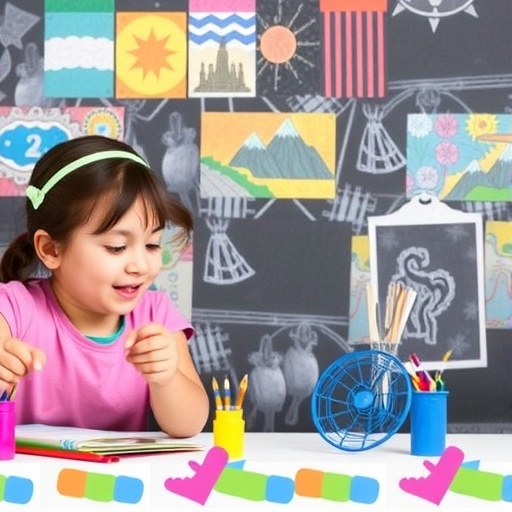Recent studies in cognitive development emphasize the increasing importance of enhancing children’s creative thinking skills. One innovative approach to this challenge is outlined in a groundbreaking new research paper by Hod-Shemer, Elgavi-Hershler, and Ben-Yehudah, published in the International Journal of Educational and Child Psychology (IJEC) in 2025. The study focuses on the use of specific prompts designed to facilitate what the authors term “controlled mental manipulation.” This term refers to a process where children are guided through imaginative exercises that encourage them to manipulate ideas, concepts, and scenarios in their minds.
The implications of developing creative thinking in children are vast. In an era increasingly defined by rapid technological advancements and complex problem-solving needs, nurturing creativity is essential. The study posits that creativity is not merely an inherent trait but a skill that can be developed and refined through structured mental exercises. Recognizing this can lead educators and parents alike to adopt new strategies that foster creative thought in a variety of learning environments.
The research highlighted in the article points to several cognitive benefits associated with these controlled mental manipulation prompts. Through systematic exercises, children can learn to approach problems from multiple angles, enhancing their critical thinking skills in the process. This is crucial because creative thinking is not limited to artistic endeavors; it extends into science, mathematics, and everyday problem-solving. The authors argue that by encouraging flexible thinking, children can become more adept at navigating the complexities of learning and real-world challenges.
One notable aspect of the study is the authors’ methodology. They conducted experiments with children across a range of ages, incorporating a diverse array of prompts to assess their effectiveness in stimulating creative thinking. The prompts varied in complexity and context, allowing researchers to gauge how different types of mental manipulation affected the children’s creative output. This approach not only allowed for a comprehensive analysis but also underscored the adaptability of the methods, making them applicable in various educational settings.
In addition to the cognitive benefits, the authors discuss the emotional impact of engaging in creative thinking exercises. Children who participate in activities that promote autonomy in thought and expression are more likely to develop a sense of self-efficacy. This positive reinforcement encourages them to tackle new challenges with confidence and resilience. Such emotional development is foundational for building a growth mindset, where failure is viewed as a learning opportunity rather than a setback.
Moreover, the social implications of nurturing creative thinking in children cannot be underestimated. In collaborative environments, children who engage in creative problem-solving are often better equipped to communicate their ideas effectively. This not only enhances their interpersonal skills but also prepares them for future careers where collaboration is key. The study shows how creativity drives innovation, suggesting that fostering these skills early can lead to a more inventive and resourceful generation.
The authors also delve into the potential barriers that inhibit creative thinking during childhood. They identify common pitfalls such as an overemphasis on rote learning and standardized testing in educational systems, which can stifle a child’s natural curiosity and ability to think outside the box. By shedding light on these obstacles, the research advocates for a paradigm shift in educational philosophy—one that prioritizes creative thinking alongside traditional academic skills.
What sets this research apart is its actionable framework for educators. The prompts outlined in the study are not theoretical; they are practical tools that can be readily incorporated into classrooms or at home. The authors provide detailed descriptions of each prompt and how to effectively implement them in various contexts. This empowers caregivers and teachers to actively engage children in creative exercises that can reshape their approach to learning.
The study also invites further exploration into the neurological mechanisms behind creative thinking in children. While the authors offer a solid foundation, they acknowledge that ongoing research is necessary to fully understand the brain’s response to creative stimuli. This opens the door for future studies that could integrate neuroscience with educational practices, paving the way for a more comprehensive understanding of how creativity can be cultivated.
In a rapidly evolving world where adaptability is paramount, the importance of fostering creative thinking in children will only continue to grow. As articulated in the research, empowering children to manipulate thoughts and ideas can have far-reaching effects on their cognitive development and future success. This research serves as a clarion call for educators, parents, and policymakers to prioritize creative thinking as a key component of childhood education.
In conclusion, the significant findings from this study shed light on how structured mental manipulation can enhance children’s creative thinking. By implementing the proposed strategies, stakeholders in the educational system can contribute to developing a generation of thinkers who are not only capable but also imaginative and innovative. As we move forward, the integration of these insights into everyday practices could redefine how children learn to embrace creativity.
Thus, the work of Hod-Shemer, Elgavi-Hershler, and Ben-Yehudah not only paves the way for future research but also ignites a conversation about the critical role of creativity in education. As the world continues to seek solutions to ever-complex challenges, cultivating young minds equipped with creative problem-solving skills is an investment worth making.
Subject of Research:
Article Title:
Article References:
Hod-Shemer, O., Elgavi-Hershler, O. & Ben-Yehudah, G. Enhancing Children’s Creative Thinking Through Prompts for Controlled Mental Manipulation.
IJEC (2025). https://doi.org/10.1007/s13158-025-00426-4
Image Credits: AI Generated
DOI:
Keywords:




